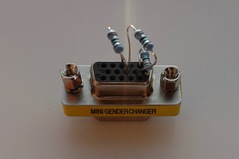jmtd → hardware → phobos → J1900N-D3V
For the first five years of its life, my NAS used a Gigabyte J1900-D3V mainboard. After those five years it died, so I've moved the specific notes about the board from the main NAS page to here.
- Gigabyte J1900N-D3V Celeron SoC, (Intel ARK)
- Delock MiniPCIe Sata III card (not in active use)
- VGA dummy dongle (see below)
This Gigabyte mainboard has some quirks, most of which are listed below. In terms of hardware design, the mini-PCI slot is in a strange place on the board. There is no easy way to secure a mini-PCI card if inserted into the board – the card will protrude at roughly 45° from the plane of the board and if you try to smooth it down it extends beyond the board dimensions so there's no way to secure it with a screw or similar. I've found trying to plug SATA ports into it is enough to loosen the connection.
Firmware
Headless boot
Sadly, Vs 1-4 of the firmware for the Gigabyte board requires a connected display in order to boot in UEFI mode. This seriously limits the utility of this system, as I want to keep the machine on a bookshelf, away from my desk and any convenient display. It's possible that a newer firmware version fixes this.
I've had a report from someone else with this board that they can boot headless in legacy/CSM mode, with a old-style DOS partition table (not GPT).
In my case, I've constructed a dummy VGA plug that fools the board into thinking that there is an attached monitor. I bought a 15 pin D-SUB gender changer and three 15 Ohm resistors. Connecting the resistors across pins 1-6, 2-7, 3-8 (Red signal to Red ground, etc.) is sufficient.
USB keyboards with integrated hubs
My go-to external keyboard is an IBM Thinkpad Ultranav USB. It presents itself as a USB hub with a keyboard attached, because it has two USB ports built into it (and two pointing devices too). Sadly with V1 of the Firmware, you can't use this keyboard to operate the firmware. However this was fixed by Version 4.
Flashing firmware
I've managed this only twice. It's pretty tricky. If you get it to work I'd recommend keeping the USB stick that worked for future updates.
Build a FreeDOS USB stick and put the DOS-based flasher onto it. In the Gigabyte Firmware, ensure
- CSM is enabled
- boot mode dual (legacy, UEFI) or UEFI only
Oddly despite needing a legacy partition layout it's the UEFI boot that needs to run.
For me, the 'fdos' boot option (once the USB bootloader has been launched) did not
work and I needed to use the 'odin' (cut-down freedos) option to proceed, but having
done that I could run the flasher (which was on drive C:).
USB issues
My case (Coolermaster Elite 110) has some front-mounted USB ports that are blue coloured and described as USB 3. However, the mainboard only offers USB 2.0/1.1 via the header for such ports. I have problems with connecting block devices to these ports.
